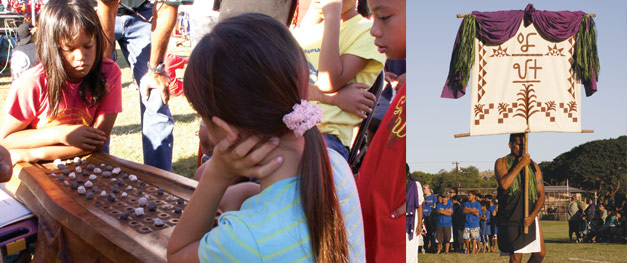
Like her kupuna before her, Pescaia is deeply involved in Makahiki. She helps prepare middle- and high-school students who come to participate. She takes the best of the best, the students chosen to represent each school, to Naiwa. She tells them of their ancestors who boxed, chanted, and danced for the glory of their homes and their families on those same sacred grounds. They hear stories of the ultimate sacrifice, how a makua (parent, uncle) would come to Naiwa to give his last breath (ha) to a young man, imparting the elder’s wisdom, knowledge and strength to help make the youth the best competitor he could be. The elder and youth touched noses, breathing the same air. “Everything I have, I give to you.” “Everything” included breath itself, after which the elder died.
After telling the students this, Pescaia asks how many of their parents make sacrifices for their sports or studies, and how many of the students ever cut class or cheated on a test. “You have been blessed to receive all these wonderful things. What are you doing,” she asks, “to continue the legacy you have inherited?”
The reflowering of Hawaiian culture has brought with it a growing appreciation for the lessons of Makahiki. “It’s still important,” Kepa Maly says, “because it connects people with the sacred, familial relationship shared with the land and natural resources about them.”
Keeaumoku Kapu, taro farmer and Hawaiian cultural practitioner, says, “In pre-Contact Hawaii we could manage ourselves by identifying different moons, seasons, and stars” to help grow and harvest abundant food — enough to sustain island populations similar to today. Just as the first sighting each year of a single constellation triggered a time for renewal, he sees Makahiki as a “cultural beacon to bring reverence to the ways of the past” that sustain the land.





